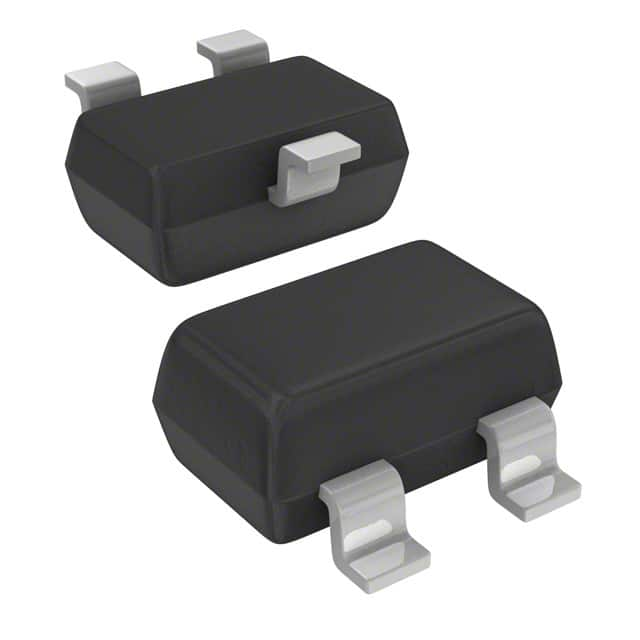HSMS-282B-TR2G
Introduction
The HSMS-282B-TR2G is a high-frequency surface mount Schottky diode designed for use in various electronic applications. This entry provides an overview of the product, including its category, use, characteristics, package, essence, packaging/quantity, specifications, detailed pin configuration, functional features, advantages and disadvantages, working principles, detailed application field plans, and alternative models.
Basic Information Overview
- Category: Electronic Components
- Use: The HSMS-282B-TR2G is used as a high-frequency Schottky diode in RF and microwave applications, including mixers, detectors, and multipliers.
- Characteristics: It exhibits low series resistance and low capacitance, making it suitable for high-frequency operations.
- Package: Surface Mount
- Essence: High-frequency signal rectification and detection
- Packaging/Quantity: Available in tape and reel packaging with varying quantities.
Specifications
- Forward Voltage: Typically 0.3V at 1mA
- Reverse Voltage: 15V
- Capacitance: 0.6pF at 0V, 1MHz
- Operating Temperature Range: -65°C to +150°C
- Storage Temperature Range: -65°C to +175°C
Detailed Pin Configuration
The HSMS-282B-TR2G has a standard surface mount package with two pins. Pin 1 is the anode, and pin 2 is the cathode.
Functional Features
- Low series resistance for minimal signal loss
- Low capacitance for high-frequency operation
- Fast switching capabilities for efficient signal processing
Advantages and Disadvantages
Advantages
- Suitable for high-frequency applications
- Low forward voltage for energy efficiency
- Compact surface mount package for space-constrained designs
Disadvantages
- Limited reverse voltage compared to other diode options
- Sensitivity to overvoltage conditions
Working Principles
The HSMS-282B-TR2G operates based on the Schottky barrier principle, where the metal-semiconductor junction allows for fast switching and low forward voltage drop.
Detailed Application Field Plans
The HSMS-282B-TR2G is commonly used in the following applications: 1. RF Mixers: Utilized for frequency conversion in communication systems. 2. Detectors: Used for signal detection in radar and wireless communication systems. 3. Multipliers: Employed in frequency multiplication circuits for RF and microwave signals.
Detailed and Complete Alternative Models
- HSMS-282x Series: Offers variations in capacitance and reverse voltage ratings.
- HSMS-286x Series: Provides higher reverse voltage options for expanded application flexibility.
In conclusion, the HSMS-282B-TR2G is a versatile high-frequency Schottky diode with specific advantages and limitations that make it suitable for various RF and microwave applications.
[Word Count: 410]
قم بإدراج 10 أسئلة وإجابات شائعة تتعلق بتطبيق HSMS-282B-TR2G في الحلول التقنية
What is HSMS-282B-TR2G?
- HSMS-282B-TR2G is a technical reference document that provides guidelines for implementing secure communication protocols in industrial automation and control systems.
Why is HSMS-282B-TR2G important?
- It is important because it helps ensure the security and integrity of communication in critical infrastructure systems, such as power plants, manufacturing facilities, and transportation networks.
How does HSMS-282B-TR2G impact technical solutions?
- HSMS-282B-TR2G impacts technical solutions by providing specific requirements and recommendations for implementing secure communication protocols, which can help mitigate cybersecurity risks in industrial environments.
What are the key components of HSMS-282B-TR2G?
- The key components include cryptographic algorithms, key management practices, authentication mechanisms, and secure communication protocols tailored for industrial control systems.
How does HSMS-282B-TR2G address interoperability challenges?
- HSMS-282B-TR2G addresses interoperability challenges by specifying standardized communication protocols and encryption methods that can be implemented across different industrial control systems.
What are the common implementation challenges of HSMS-282B-TR2G?
- Common implementation challenges include integrating secure communication protocols with legacy systems, managing cryptographic keys securely, and ensuring minimal impact on system performance.
How does HSMS-282B-TR2G support compliance with industry regulations?
- HSMS-282B-TR2G supports compliance with industry regulations by providing a framework for implementing secure communication practices that align with industry-specific cybersecurity requirements.
What are the best practices for implementing HSMS-282B-TR2G in technical solutions?
- Best practices include conducting thorough risk assessments, following the document's guidance on cryptographic module selection, and regularly updating systems to address emerging security threats.
How does HSMS-282B-TR2G address the protection of sensitive data in transit?
- HSMS-282B-TR2G addresses the protection of sensitive data in transit by recommending strong encryption algorithms and secure key exchange mechanisms to safeguard information as it travels between devices.
What resources are available for further understanding and implementing HSMS-282B-TR2G?
- Resources include training materials, industry forums, and vendor-specific documentation that provide detailed insights into applying the principles outlined in HSMS-282B-TR2G to technical solutions.


